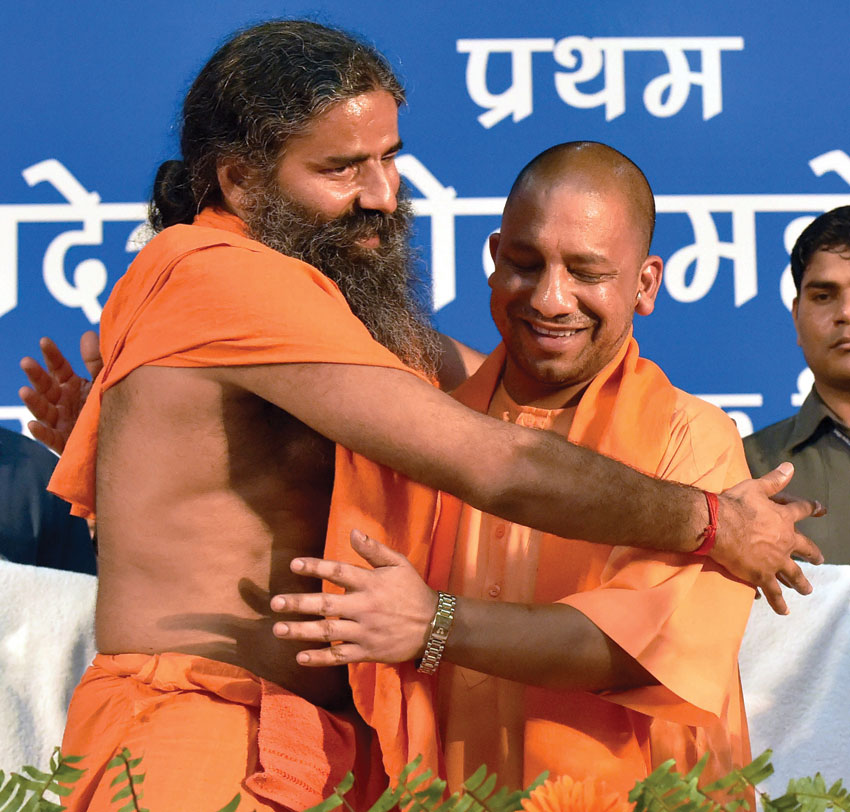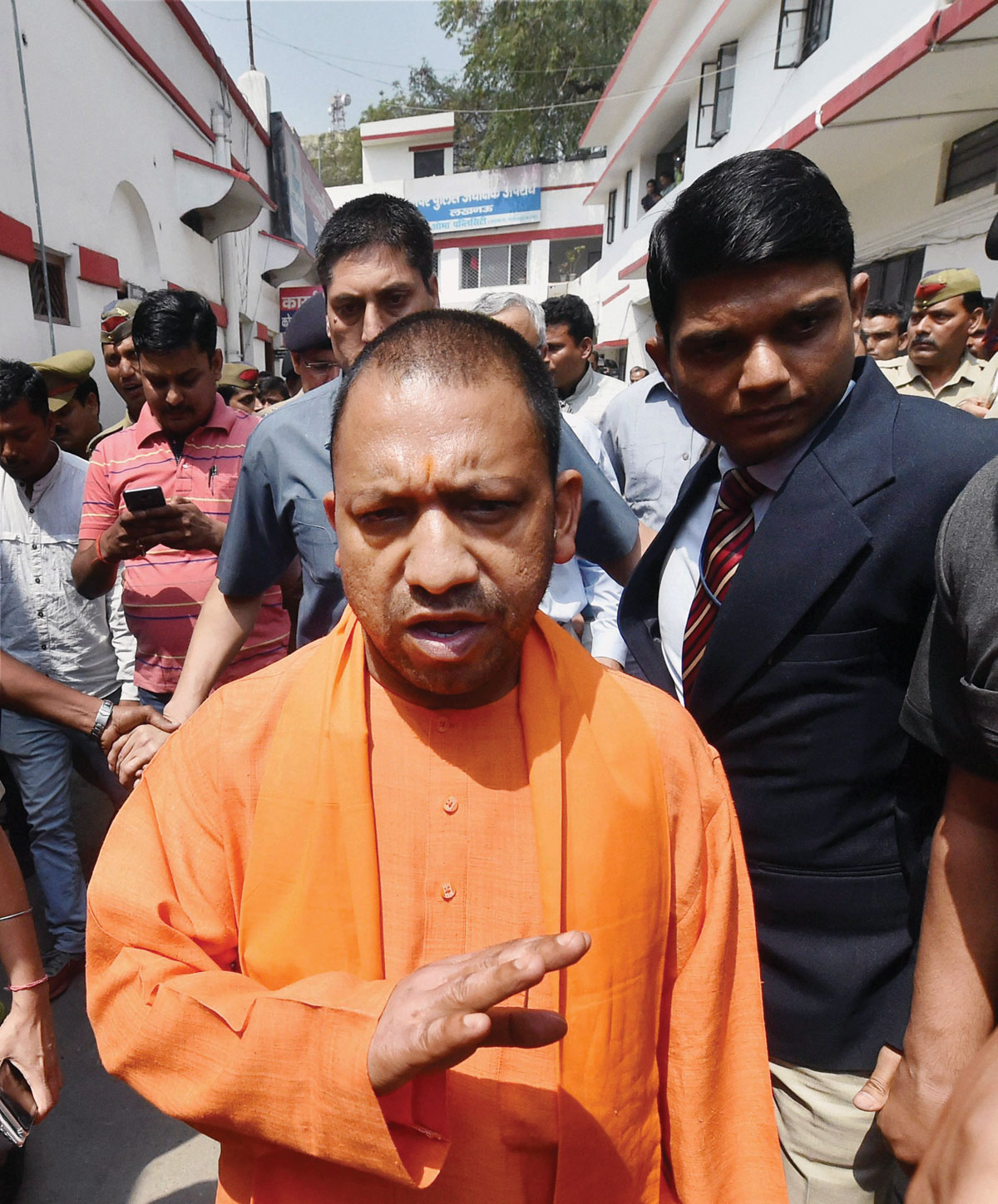Decoding Yogi Adityanath’s Elevation: Modi’s Unconventional CM Choice
Newly-elected Uttar Pradesh Chief Minister Yogi Adityanath pays a surprise visit to the Hazratganj police station in Lucknow, March 23. (Nand Kumar/PTI)
The mother of all surprises was that of all the contenders to the seat of Chief Minister of U.P., one of the largest and most populous states and hence the most important, Yogi Adityanath emerged as the winner, thereby compelling the commentating classes and media to join the cry of opposition and speculation over promises of a “New India” by Modi getting sabotaged even before takeoff at the altar of majoritarian fundamentalism, writes Priyanka Bhardwaj. – @Siliconeer #Siliconeer #India #UttarPradesh #YogiAdityanath #BJP @NaMo #NaMo @Narendramodi #NarendraModi
The Bharatiya Janata Party, led by Prime Minister Narendra Modi, has proved every skeptic wrong by its stunning election victories in the state assemblies of Uttar Pradesh and Uttarakhand, and displaying realpolitik by a quick cobbling together of a majority despite being a minority in both Goa and Manipur.
Particularly in U.P. this mandate of 324 seats out of a total of 403 registered the biggest majority for any party in the state since 1980.
Slamming the critics Finance Minister Arun Jaitely termed the win as an implicit public endorsement of “demonetization,” a ruling widely believed to have had the worst impact on the underprivileged class and wage earners.
However, the mother of all surprises was that of all the contenders to the seat of Chief Minister of U.P., one of the largest and most populous states and hence the most important, Yogi Adityanath emerged as the winner, thereby compelling the commentating classes and media to join the cry of opposition and speculation over promises of a “New India” by Modi getting sabotaged even before takeoff at the altar of majoritarian fundamentalism.
So who is this Yogi?
Yogi Adityanath is a 45 year old Mahant (head priest) of Gorakhnath Mutt, a Hindu temple in Gorakhpur in the northeastern part of U.P., close to the Nepal border.
A firebrand “Hindu nationalist” and powerful orator, he has won five consecutive terms in Lok Sabha (lower house of Parliament) from the Gorakhpur constituency on the BJP ticket.
Born into a Garhwali Rajput family in a village of Uttarakhand, Ajay Singh Bisht (his name before joining the Mutt) graduated in Mathematics, joined the Ayodhya Ram Temple movement in the 1990s, and became a disciple of Mahant Avaidyanath of Gorakhnath Mutt.
The Naths of this Mutt are “kanphata” (split-eared) yogis and worshippers of Adinath, a synonym of Shiva.
They trace the origin of their monastery to the legendary Yogi Gorakshanath who is believed to have lived during the 10th and 14th centuries, and influenced the poetry of contemporary Bhakti leaders such as Kabir and Guru Nanak of Sikhism.
Generally found in north India and Nepal, such as Gorakhpur, Haridwar and Kathmandu, the Naths enjoyed royal patronage from the likes of Raja Man Singh of Marwar or Jodhpur who renounced rule to become a yogi towards the end of his life, and held political sway from Punjab to Rajasthan since many centuries.
Contemporarily too, sadhus (Celibate monks), mullahs (Muslim priests) and fakirs (wandering ascetics) have dabbled in politics with much impact and controversy.
Since the Constitution does not bar any politically elected leader from becoming the head of a state the ochre color of Yogi Adityanath’s clothes cannot be held against his ascension.

What definitely raised hysteria, massively amplified by social media, were his views on appeasement politics, “ghar wapasi” (re-conversion), and advocacy of strong arm-tactics over “love-jihad” and cow protection.
There are cases registered against him for allegedly trying to capture graveyard land by planting a Peepal tree at Panch Rukhiya village in Maharajganj district and provoking riots following the killing of a Hindu youth on one occasion and rape of a minor Hindu girl on another, and of sharing the stage with a rabble-rouser.
While it is only time that will test Yogi on his true credentials as his policies and actions slowly unfold, it may be noteworthy to list the probable reasons that may have aided his elevation as the first among equals, and a parallel can be drawn with the somewhat similar rise of Modi in Gujarat in 2001.
Yogi’s persona of a straight talking, strategic thinking, discipline and ability to put in grueling hours and taking tough decisions are all too apparent in his astute sense of politics and administration.
What however must have been his winning card is the favorable socio-religious-literary legacy of the Naths who had been proponents of casteless society before becoming votaries of Ram Mandir.
His heading of Hindu Yuva Vahini, a Hindu youth outfit, comprising of backward and Dalit caste young men provided with human resource that could be leveraged by the ideological group of BJP, the Rashtriya Swayamsevak Sangh, with which he maintains a definite link.
Moreover being a Rajput Garhwali, he fit well into Modi’s preference of a community neutral and unconventional choice that would dissuade any negative response of voters during future electoral rounds.
It is a model carefully doctored by BJP’s master-strategist, Amit Shah of donning the superstructure with Modi’s charisma that rests on a strong base of authentic grassroots leaders commanding a stable and large voting base.
Since there were no favorite horses or pre-election announcement of a Chief Ministerial candidate, Yogi’s selection based on popular appeal was an easy task.
Generally in politics it has been seen that power sublimates the identity politics of leaders in favor of governance and there are more chances of Yogi understanding the future political dividends if he takes up cudgels to clean up the mess in the state.
U.P. has always been a difficult state to govern, with pre-existing fault lines that are too sectarian in nature, but if Yogi be the choice, expectations of a marked improvement cannot be dubbed too high.
Even before the announcement of his Cabinet, Yogi has initiated many programs such as the shutting down of illegal abattoirs as per National Green Tribunal orders, asked all officials and politicians to declare their assets and get ready to work 18-20 hours a day or leave the state for good, banned chewing of tobacco, a carcinogenic product, in offices, and a crackdown by the “anti-Romeo” squads to secure the fairer sex.
These measures, however thorny in some respects, are part of BJP’s election manifesto and may be assessed as course correction.
One cannot forget that this is one state where erstwhile Chief Minister Mulayam Singh Yadav attempted to normalize routine rapes of even minor girls with his sexist remarks, “Dekhiye ladke hain, galti ho gayi” (Boys will be boys, they make mistakes).
Therefore, if Modi has displayed valor in facing accusations of committing the ultimate heresy of choosing a “communal guy,” then the onus of proving detractors wrong lies only with Yogi.
Yogi, who commands high esteem from people of all faiths in his own constituency, may actually tend to widen his base with his “development along with cow” model and ensuring the plurality of social fabric without the cynical manipulations of the Muslim vote or losing rein on the Hindu Right.
This chance to govern and grow is too valuable to be lost and Yogi must know that!


